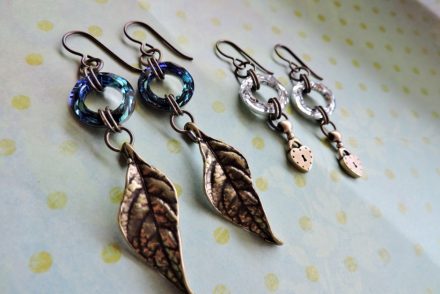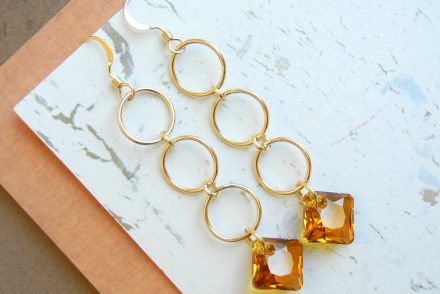Little butane torches are sweet, and not just because they are often used to caramelize sugar on fancy desserts. Micro torches are great for a ton of jewelry making techniques – soldering, fusing fine silver, sintering small Art Clay Silver pieces, even enameling. One really fun and easy project for the micro torch is balling up wire to make your own ball-end head pins.
Supplies needed:
 Non-plated wire (I’m using fine silver wire. Sterling silver and copper wire also work. Brass, nickel silver, steel and coated craft wires do not.)
Non-plated wire (I’m using fine silver wire. Sterling silver and copper wire also work. Brass, nickel silver, steel and coated craft wires do not.)
Butane (sold at most hardware and general stores)
Bowl of water
 Making DIY head pins is addictive. Using the locking tweezers, simply hold the wire vertically above the bowl of water. Heat the end of the wire with the torch.
Making DIY head pins is addictive. Using the locking tweezers, simply hold the wire vertically above the bowl of water. Heat the end of the wire with the torch.
 As the wire starts to melt, it crawls up the wire. Once you have a good size ball, quench the wire in the water. Ta da!
As the wire starts to melt, it crawls up the wire. Once you have a good size ball, quench the wire in the water. Ta da!
If you get too ambitious, the ball might get too big and drop off the wire. Not a big deal. The little balls make cute additions to other projects, and the water ensures you’re not burning down the house. A little practice is all it takes to consistently make the balls the same size.
 The balled wire also makes nice French hook ear wires. Don’t have a torch? Rings & Things micro torch kit contains everything you need to get started, except the fuel. A book such as Soldering Made Simple: Easy techniques for the kitchen-table jeweler or Melissa Manley’s Jewelry Lab will provide loads of inspiration and how-tos for more complicated projects that take full advantage of your new tool’s powers! ~ Cindy
The balled wire also makes nice French hook ear wires. Don’t have a torch? Rings & Things micro torch kit contains everything you need to get started, except the fuel. A book such as Soldering Made Simple: Easy techniques for the kitchen-table jeweler or Melissa Manley’s Jewelry Lab will provide loads of inspiration and how-tos for more complicated projects that take full advantage of your new tool’s powers! ~ Cindy




20 Comments
I’d love to be able to streamline this process. Do you know of any device that allows you to hold more than one wire at a time to make multiple balled headpins?
Hi Jill,
To the best of my knowledge, this is the type of device that people have to create themselves. (A surprising amount of specialized jewellers tools are that way.) Some type of heat-resistant clamp (perhaps a pivoting vice?) that can be loaded up while sitting sideways, firmly clamped, then hung upside down at just the right height.
I’ve seen some experienced people make ball-end head pins by hand, and even one at a time, it looks impressively fast. Hold, ball, drop. Hold, ball, drop. … but I can imagine that the “hold” part would get very tiresome after a few hundred head pins!
You can use lock tweezers for sure, to limit the hand clenching needed when doing a lot repeatedly. Also, I ball up one longer piece of wire on both ends and then just cut it into two when I’m ready to use it. You have to be pretty precise doing it this way, so your wire doesn’t end up being too short. Also you can hold 5-6 in a bent pair of lock tweezers, if you bend it right.
Hope that helps!
I wish I had seen the photos before I commented before, they weren’t loading…obviously, you used lock tweezers, and I didn’t read carefully enough the first time. Also, I just wanted to add that you can ball up brass wire if you dip it in Flux first. I was trying to figure that out and that’s what brought me to this page. Just took a little more thinking, but I figured it out:)
Hi Jennifer,
Thanks for posting your helpful tips! This is one of the things I love about the world of Handmade.
~Polly
‘When I make these headpins, everything is fine, but I don’t get a nice shiny ball at the tip, mine looks kind of pitted and scared up. What can I do to fix this?
Thanks!
Hi Mary Beth,
I believe the pits are from impurities either in the flame or the silver itself. You might want to try a higher grade of butane (we use triple-refined), or try using fine silver instead of sterling silver. It might also help to clean the silver with a little flux or isopropyl alcohol.
Also – what part of the flame are you using? Are you in the smaller blue cone, or out in the larger more-diffuse brighter part of the flame? If you’re not using that smaller blue cone of flame, turn down the lights and try adjusting your flame so that little cone is sharply defined, and heat your metal in that nice little hot spot. ~Polly
Hi Mary Beth,
I heard that a recent batch of sterling silver wire from a major online distributor (not us!) has an unknown contaminant that is causing the problem you are describing. I believe it is still .925, so what they are selling is not illegal, but it does not ball up nicely.
In other words, you might not be doing anything wrong; it might just be a batch of sterling silver wire that pits instead of balling up nicely.
You might want to contact your vendor to find out if this is a known problem ~Polly
Will this work with German silver wire or silver filled wire?
Hi Krithika,
No, it won’t. German silver wire is a wide variety of different possible alloys, rather than one particular alloy. Each alloy will have a different melting point, and most of them should be soldered with simple “soft solder” and an electric soldering gun, similar to the type used in the stained glass industry.
And Silver Filled wire has a core of one type of wire (often brass), with a thick layer of silver around this core. The core layer and the outer layer have different melting temperatures, so can’t be torch fired.
~ Polly
Does it work with argentium silver?
Hi Laurel,
Yes, Argentium silver wire works too.
We found that fine silver, sterling silver, and Argentium silver each behaved slightly differently, but all worked.
Fine silver was the easiest to control, and basic sterling silver wire was the toughest to control.
Argentium is a special form of sterling silver, so behaved similarly, but didn’t require as much cleanup since it doesn’t develop firescale.
~Polly
Would this work with 14k gold wire? I’m looking everywhere for a solution.
Hi Ariana,
Yes, it should, but you will need a higher powered torch. A butane micro torch doesn’t get hot enough. You should be able to find the flow temperature for 14kt wire, where you purchase(d) your 14kt wire. Also more information about the type of jeweler’s torch that you need. –Polly
What gauge of wire are you using and do you know how large of wire can be balled with a micro torch?
Thanks!
Hi Big Al,
This works with 26g to 22g wire. We mostly used 24g. Thinner wire balls easier; this was very easy with 26g and 24g using a butane micro torch, but was pretty easy with 22g too; it just took a little more focus.
We weren’t trying to make a very large ball; we were going for quick and consistent, about the same size as the usual ones you can buy ready-made, so I’m really not sure what you can do with a little practice trying to make larger ones. Sorry my answer to your second question was vague; I’m afraid I don’t have time to do the experimenting currently to get you a better answer. To be honest, I’m not sure I’m patient enough to find out. =) It might vary a bit from torch to torch, too.
~Polly
Can you use a flame off a gas cooker? Just to try before buying a tool!
Hi Simone,
I don’t think the angle would work well.
Check the photos above for how we did ours. We had a bowl of water underneath, and the flame at the side. I think trying to make ball-end head pins over a gas cooking stove would be very difficult. And since I have a butane micro torch, and I don’t have a gas cook stove, I’m not very tempted to track down a neighbor who is willing to let me experiment on theirs!
I did a quick google search and didn’t find anyone else saying they suggest it. This doesn’t mean it’s impossible, just that no one who has tried it, has posted anything about it that I can find.
~Polly
I’ve seen jewelry in which a ball pin is used to hold a bead – with a ball head on each end. So, a hole has been drilled in the silver, the ball pin has been put through the hole with a bead, then the wire on the other side of the hole has been heated to create a ball pin – holding it all together. How is this accomplished without burning up the bead?
Hi Barbara,
I haven’t done that, so I’m not exactly sure. You might only be able to do it with certain materials. However, I have soldered links with gemstone beads on them: http://blog.rings-things.com/2013/03/07/copper-soldering-tutorial-part-2/ — you might be able to do something similar with certain types of beads and metals. I think Argentium silver might ball up faster and easier than regular sterling silver. ~Polly